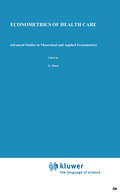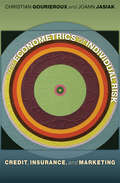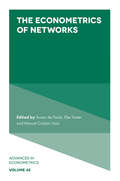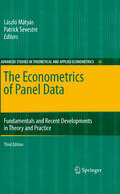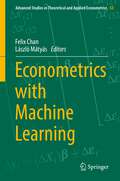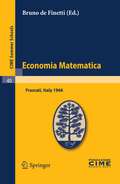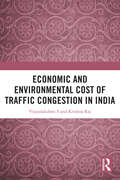- Table View
- List View
Econometrics of Financial High-Frequency Data
by Nikolaus HautschThe availability of financial data recorded on high-frequency level has inspired a research area which over the last decade emerged to a major area in econometrics and statistics. The growing popularity of high-frequency econometrics is driven by technological progress in trading systems and an increasing importance of intraday trading, liquidity risk, optimal order placement as well as high-frequency volatility. This book provides a state-of-the art overview on the major approaches in high-frequency econometrics, including univariate and multivariate autoregressive conditional mean approaches for different types of high-frequency variables, intensity-based approaches for financial point processes and dynamic factor models. It discusses implementation details, provides insights into properties of high-frequency data as well as institutional settings and presents applications to volatility and liquidity estimation, order book modelling and market microstructure analysis.
Econometrics of Health Care (Advanced Studies in Theoretical and Applied Econometrics #20)
by G. Duru Jean H. Paul PaelinckEconometrics of Health Care - which we have sometimes called 'medico metrics' - is a field in full expansion. The reasons are numerous: our knowl edge of quantitative relations in the field of health econometrics is far from being perfect, a large number of analytical difficulties - combining medical (latent factors, e. g. ) and economic facts (spatial behaviour, e. g. ) are faced by the research worker, medical and pharmaceutical techniques change rapidly, medical costs rocket more than proportionally with available resources, of being tightened. medical budgets are in the process So it is not surprising that the practice of 'hygieconometrics' - to produce a neologism - is more and more included in the programmes of econometri cians. The Applied Econometrics Association has devoted to the topic two symposia in less than three years (Lyons, February 1983; Rotterdam, December 1985), without experiencing any difficulties in getting valuable papers: on econometrics of risks and medical insurance, on the measurement of health status and of efficiency of medical techniques, on general models allowing simulation. These were the themes for the second meeting, but other aspects of medical-economic problems had presented themselves already to the analyst: medical decision making and its consequences, the behaviour of the actors - patients and physicians -, regional medicometrics and what not: some of them have been covered by the first meeting. Finally, in July 1988 took place in Lyons the Fourth International Conference on System Science in Health Care; it should not be astonishing .
The Econometrics of Individual Risk: Credit, Insurance, and Marketing
by Christian Gourieroux Joann JasiakThe individual risks faced by banks, insurers, and marketers are less well understood than aggregate risks such as market-price changes. But the risks incurred or carried by individual people, companies, insurance policies, or credit agreements can be just as devastating as macroevents such as share-price fluctuations. A comprehensive introduction, The Econometrics of Individual Risk is the first book to provide a complete econometric methodology for quantifying and managing this underappreciated but important variety of risk. The book presents a course in the econometric theory of individual risk illustrated by empirical examples. And, unlike other texts, it is focused entirely on solving the actual individual risk problems businesses confront today. Christian Gourieroux and Joann Jasiak emphasize the microeconometric aspect of risk analysis by extensively discussing practical problems such as retail credit scoring, credit card transaction dynamics, and profit maximization in promotional mailing. They address regulatory issues in sections on computing the minimum capital reserve for coverage of potential losses, and on the credit-risk measure CreditVar. The book will interest graduate students in economics, business, finance, and actuarial studies, as well as actuaries and financial analysts.
The Econometrics of Individual Risk: Credit, Insurance, and Marketing
by Christian Gourieroux Joann JasiakThe individual risks faced by banks, insurers, and marketers are less well understood than aggregate risks such as market-price changes. But the risks incurred or carried by individual people, companies, insurance policies, or credit agreements can be just as devastating as macroevents such as share-price fluctuations. A comprehensive introduction, The Econometrics of Individual Risk is the first book to provide a complete econometric methodology for quantifying and managing this underappreciated but important variety of risk. The book presents a course in the econometric theory of individual risk illustrated by empirical examples. And, unlike other texts, it is focused entirely on solving the actual individual risk problems businesses confront today. Christian Gourieroux and Joann Jasiak emphasize the microeconometric aspect of risk analysis by extensively discussing practical problems such as retail credit scoring, credit card transaction dynamics, and profit maximization in promotional mailing. They address regulatory issues in sections on computing the minimum capital reserve for coverage of potential losses, and on the credit-risk measure CreditVar. The book will interest graduate students in economics, business, finance, and actuarial studies, as well as actuaries and financial analysts.
Econometrics of Information and Efficiency (Theory and Decision Library B #25)
by Jati SenguptaEconometrics as an applied discipline attempts to use information in a most efficient manner, yet the information theory and entropy approach developed by Shannon and others has not played much of a role in applied econometrics. Econometrics of Information and Efficiency bridges the gap. Broadly viewed, information theory analyzes the uncertainty of a given set of data and its probabilistic characteristics. Whereas the economic theory of information emphasizes the value of information to agents in a market, the entropy theory stresses the various aspects of imprecision of data and their interactions with the subjective decision processes. The tools of information theory, such as the maximum entropy principle, mutual information and the minimum discrepancy are useful in several areas of statistical inference, e.g., Bayesian estimation, expected maximum likelihood principle, the fuzzy statistical regression. This volume analyzes the applications of these tools of information theory to the most commonly used models in econometrics. The outstanding features of Econometrics of Information and Efficiency are: A critical survey of the uses of information theory in economics and econometrics; An integration of applied information theory and economic efficiency analysis; The development of a new economic hypothesis relating information theory to economic growth models; New lines of research are emphasized.
The Econometrics of Major Transport Infrastructures (Applied Econometrics Association Series)
by Emile Quinet Roger VickermanMajor transport infrastructures are increasingly in the news as both the engineering and financing possibilities come together. However, these projects have also demonstrated the inadequacy of most existing approaches to forecasting their impacts and their overall evaluation. This collection of papers from a conference organised by the Applied Econometric Association represents a state of the art look at issues of forecasting traffic, developing pricing strategies and estimating the impacts in a set of papers by leading authorities from Europe, North America and Japan.
The Econometrics of Multi-dimensional Panels: Theory and Applications (Advanced Studies in Theoretical and Applied Econometrics #50)
by Laszlo MatyasThis book presents the econometric foundations and applications of multi-dimensional panels, including modern methods of big data analysis. The last two decades or so, the use of panel data has become a standard in many areas of economic analysis. The available models formulations became more complex, the estimation and hypothesis testing methods more sophisticated. The interaction between economics and econometrics resulted in a huge publication output, deepening and widening immensely our knowledge and understanding in both. The traditional panel data, by nature, are two-dimensional. Lately, however, as part of the big data revolution, there has been a rapid emergence of three, four and even higher dimensional panel data sets. These have started to be used to study the flow of goods, capital, and services, but also some other economic phenomena that can be better understood in higher dimensions. Oddly, applications rushed ahead of theory in this field. This book is aimed at filling this widening gap. The first theoretical part of the volume is providing the econometric foundations to deal with these new high-dimensional panel data sets. It not only synthesizes our current knowledge, but mostly, presents new research results. The second empirical part of the book provides insight into the most relevant applications in this area. These chapters are a mixture of surveys and new results, always focusing on the econometric problems and feasible solutions.
The Econometrics of Networks (Advances in Econometrics #42)
by Áureo De Paula, Elie Tamer, Marcel-Cristian VoiaThis volume in Advances in Econometrics showcases fresh methodological and empirical research on the econometrics of networks. Comprising both theoretical, empirical and policy papers, the authors bring together a wide range of perspectives to facilitate a dialogue between academics and practitioners for better understanding this groundbreaking field and its role in policy discussions. This edited collection includes thirteen chapters which covers various topics such as identification of network models, network formation, networks and spatial econometrics and applications of financial networks. Readers can also learn about network models with different types of interactions, sample selection in social networks, trade networks, stochastic dynamic programming in space, spatial panels, survival and networks, financial contagion, spillover effects, interconnectedness on consumer credit markets and a financial risk meter. The topics covered in the book, centered on the econometrics of data and models, are a valuable resource for graduate students and researchers in the field. The collection is also useful for industry professionals and data scientists due its focus on theoretical and applied works.
The Econometrics of Networks (Advances in Econometrics #42)
by Áureo De Paula Elie Tamer Marcel-Cristian VoiaThis volume in Advances in Econometrics showcases fresh methodological and empirical research on the econometrics of networks. Comprising both theoretical, empirical and policy papers, the authors bring together a wide range of perspectives to facilitate a dialogue between academics and practitioners for better understanding this groundbreaking field and its role in policy discussions. This edited collection includes thirteen chapters which covers various topics such as identification of network models, network formation, networks and spatial econometrics and applications of financial networks. Readers can also learn about network models with different types of interactions, sample selection in social networks, trade networks, stochastic dynamic programming in space, spatial panels, survival and networks, financial contagion, spillover effects, interconnectedness on consumer credit markets and a financial risk meter. The topics covered in the book, centered on the econometrics of data and models, are a valuable resource for graduate students and researchers in the field. The collection is also useful for industry professionals and data scientists due its focus on theoretical and applied works.
Econometrics of Panel Data: Methods and Applications
by Erik BiørnPanel data is a data type increasingly used in research in economics, social sciences, and medicine. Its primary characteristic is that the data variation goes jointly over space (across individuals, firms, countries, etc.) and time (over years, months, etc.). Panel data allow examination of problems that cannot be handled by cross-section data or time-series data. Panel data analysis is a core field in modern econometrics and multivariate statistics, and studies based on such data occupy a growing part of the field in many other disciplines. The book is intended as a text for master and advanced undergraduate courses. It may also be useful for PhD-students writing theses in empirical and applied economics and readers conducting empirical work on their own. The book attempts to take the reader gradually from simple models and methods in scalar (simple vector) notation to more complex models in matrix notation. A distinctive feature is that more attention is given to unbalanced panel data, the measurement error problem, random coefficient approaches, the interface between panel data and aggregation, and the interface between unbalanced panels and truncated and censored data sets. The 12 chapters are intended to be largely self-contained, although there is also natural progression. Most of the chapters contain commented examples based on genuine data, mainly taken from panel data applications to economics. Although the book, inter alia, through its use of examples, is aimed primarily at students of economics and econometrics, it may also be useful for readers in social sciences, psychology, and medicine, provided they have a sufficient background in statistics, notably basic regression analysis and elementary linear algebra.
Econometrics of Panel Data: Methods and Applications
by Erik BiørnPanel data is a data type increasingly used in research in economics, social sciences, and medicine. Its primary characteristic is that the data variation goes jointly over space (across individuals, firms, countries, etc.) and time (over years, months, etc.). Panel data allow examination of problems that cannot be handled by cross-section data or time-series data. Panel data analysis is a core field in modern econometrics and multivariate statistics, and studies based on such data occupy a growing part of the field in many other disciplines. The book is intended as a text for master and advanced undergraduate courses. It may also be useful for PhD-students writing theses in empirical and applied economics and readers conducting empirical work on their own. The book attempts to take the reader gradually from simple models and methods in scalar (simple vector) notation to more complex models in matrix notation. A distinctive feature is that more attention is given to unbalanced panel data, the measurement error problem, random coefficient approaches, the interface between panel data and aggregation, and the interface between unbalanced panels and truncated and censored data sets. The 12 chapters are intended to be largely self-contained, although there is also natural progression. Most of the chapters contain commented examples based on genuine data, mainly taken from panel data applications to economics. Although the book, inter alia, through its use of examples, is aimed primarily at students of economics and econometrics, it may also be useful for readers in social sciences, psychology, and medicine, provided they have a sufficient background in statistics, notably basic regression analysis and elementary linear algebra.
The Econometrics of Panel Data: Fundamentals and Recent Developments in Theory and Practice (Advanced Studies in Theoretical and Applied Econometrics #46)
by Lászlo Mátyás Patrick SevestreThis restructured, updated Third Edition provides a general overview of the econometrics of panel data, from both theoretical and applied viewpoints. Readers discover how econometric tools are used to study organizational and household behaviors as well as other macroeconomic phenomena such as economic growth. The book contains sixteen entirely new chapters; all other chapters have been revised to account for recent developments. With contributions from well known specialists in the field, this handbook is a standard reference for all those involved in the use of panel data in econometrics.
The Econometrics of Panel Data: A Handbook of the Theory with Applications (Advanced Studies in Theoretical and Applied Econometrics #33)
by László Mátyás Patrick SevestreThe aim of this volume is to provide a general overview of the econometrics of panel data, both from a theoretical and from an applied viewpoint. Since the pioneering papers by Edwin Kuh (1959), Yair Mundlak (1961), Irving Hoch (1962), and Pietro Balestra and Marc Nerlove (1966), the pooling of cross sections and time series data has become an increasingly popular way of quantifying economic relationships. Each series provides information lacking in the other, so a combination of both leads to more accurate and reliable results than would be achievable by one type of series alone. Over the last 30 years much work has been done: investigation of the properties of the applied estimators and test statistics, analysis of dynamic models and the effects of eventual measurement errors, etc. These are just some of the problems addressed by this work. In addition, some specific diffi culties associated with the use of panel data, such as attrition, heterogeneity, selectivity bias, pseudo panels etc., have also been explored. The first objective of this book, which takes up Parts I and II, is to give as complete and up-to-date a presentation of these theoretical developments as possible. Part I is concerned with classical linear models and their extensions; Part II deals with nonlinear models and related issues: logit and pro bit models, latent variable models, duration and count data models, incomplete panels and selectivity bias, point processes, and simulation techniques.
The Econometrics of Panel Data: Handbook of Theory and Applications (Advanced Studies in Theoretical and Applied Econometrics #28)
by László Mátyás Patrick SevestreThe aim of this volume is to provide a general overview of the econometrics of panel data, both from a theoretical and from an applied viewpoint. Since the pioneering papers by Kuh (1959), Mundlak (1961), Hoch (1962), and Balestra and Nerlove (1966), the pooling of cross section and time series data has become an increasingly popular way of quantifying economic relationships. Each series provides information lacking in the other, so a combination of both leads to more accurate and reliable results than would be achievable by one type of series alone. Over the last 30 years much work has been done: investigation of the properties of the applied estimators and test statistics, analysis of dynamic models and the effects of eventual measurement errors, etc. These are just some of the problems addressed by this work. In addition, some specific diffi culties associated with the use of panel data, such as attrition, heterogeneity, selectivity bias, pseudo panels etc., have also been explored. The first objective of this book, which takes up Parts I and II, is to give as complete and up-to-date a presentation of these theoretical developments as possible. Part I is concerned with classical linear models and their extensions; Part II deals with nonlinear models and related issues: logit and probit models, latent variable models, incomplete panels and selectivity bias, and point processes.
Econometrics of Planning and Efficiency (Advanced Studies in Theoretical and Applied Econometrics #11)
by Jati Sengupta Gopal K. KadekodiEconometrics of Risk (Studies in Computational Intelligence #583)
by Van-Nam Huynh Vladik Kreinovich Songsak Sriboonchitta Komsan SuriyaThis edited book contains several state-of-the-art papers devoted to econometrics of risk. Some papers provide theoretical analysis of the corresponding mathematical, statistical, computational, and economical models. Other papers describe applications of the novel risk-related econometric techniques to real-life economic situations. The book presents new methods developed just recently, in particular, methods using non-Gaussian heavy-tailed distributions, methods using non-Gaussian copulas to properly take into account dependence between different quantities, methods taking into account imprecise ("fuzzy") expert knowledge, and many other innovative techniques.This versatile volume helps practitioners to learn how to apply new techniques of econometrics of risk, and researchers to further improve the existing models and to come up with new ideas on how to best take into account economic risks.
The Econometrics of Sequential Trade Models: Theory and Applications Using High Frequency Data (Lecture Notes in Economics and Mathematical Systems #538)
by Stefan KokotThe present study has been accepted as a doctoral thesis by the Depart ment of Economics of the Johann Wolfgang Goethe-University in Frankfurt am Main. It grew out from my five year long participation in two research projects, "Econometric analysis of transaction intensity and volatility on fi nancial markets", and "Microstructure on financial markets", that were both conducted by the chair of Statistics and Econometrics (Empirical Economic Research) at the Department of Economics and Business Administration, Jo hann Wolfgang Goethe-University in Frankfurt am Main and financed by the state of Hessen. During this time I have benefitted from many people. First and foremost I would like to thank my thesis supervisor, Prof. Dr. Reinhard Hujer, for initiating and supporting my studies with great encouragement. I am also very grateful to Prof. Dr. Christian Schlag for acting as the second thesis supervisor. Furthermore, I wish to thank Prof. Dr. Joachim Grammig who introduced me to the topics covered in this study in the first place and helped me to sharpen my views on econometrics and financial market microstructure theory through many discussions and also through his willingness to work with me on several related studies.
Econometrics with Machine Learning (Advanced Studies in Theoretical and Applied Econometrics #53)
This book helps and promotes the use of machine learning tools and techniques in econometrics and explains how machine learning can enhance and expand the econometrics toolbox in theory and in practice. Throughout the volume, the authors raise and answer six questions: 1) What are the similarities between existing econometric and machine learning techniques? 2) To what extent can machine learning techniques assist econometric investigation? Specifically, how robust or stable is the prediction from machine learning algorithms given the ever-changing nature of human behavior? 3) Can machine learning techniques assist in testing statistical hypotheses and identifying causal relationships in ‘big data? 4) How can existing econometric techniques be extended by incorporating machine learning concepts? 5) How can new econometric tools and approaches be elaborated on based on machine learning techniques? 6) Is it possible to develop machine learning techniques further and make them even more readily applicable in econometrics?As the data structures in economic and financial data become more complex and models become more sophisticated, the book takes a multidisciplinary approach in developing both disciplines of machine learning and econometrics in conjunction, rather than in isolation. This volume is a must-read for scholars, researchers, students, policy-makers, and practitioners, who are using econometrics in theory or in practice.
Economia Matematica: Lectures given at a Summer School of the Centro Internazionale Matematico Estivo (C.I.M.E.) held in Frascati (Roma), Italy, August 22-30,1966 (C.I.M.E. Summer Schools #40)
by Bruno De FinettiS.N. Afriat: Economic transformation.- M. Arcelli: Modelli aumentati e principio di corrispondenza nella metodologia di Andreas.- H. Kuhn: Some remarks on games of fair division.- H. Kuhn: On two theorems in international trade.- A.G. Papandreou: Theory, construction and empirical meaning in economics.
Economic Analysis in Historical Perspective: Butterworths Advanced Economics Texts
by J. Creedy D. P. O'BrienEconomic Analysis in Historical Perspective offers a wide discussion on economics and its history. One of the book’s main principles is to place the several major areas of economic analysis in historical perspective. The book’s first topic is about monetary economics; it includes subtopics such as concepts of money, supply and demand of money, monetary control, and rate of interest. The next chapter highlights the economics of welfare, including its nature, modern issues, classical paradigm, and advancements. In Chapter 4, the main topics are public finance, taxes, and the government’s role in all of it. This chapter also elaborates on public expenditure, taxation, and income redistribution. In the last remaining chapters, the discussion circles around the topic’s relevant theories, metrics, and statistics. The text serves as a valuable reference to undergraduates or postgraduates of economics.
An Economic Analysis of Conflicts: With an Application to the Greek Civil War 1946-1949
by Nicos ChristodoulakisThis book provides a quantitative framework for the analysis of conflict dynamics and for estimating the economic costs associated with civil wars. The author develops modified Lotka-Volterra equations to model conflict dynamics, to yield realistic representations of battle processes, and to allow us to assess prolonged conflict traps. The economic costs of civil wars are evaluated with the help of two alternative methods: Firstly, the author employs a production function to determine how the destruction of human and physical capital stocks undermines economic growth in the medium term. Secondly, he develops a synthetic control approach, where the cost is obtained as the divergence of actual economic activity from a hypothetical path in the absence of civil war. The difference between the two approaches gives an indication of the adverse externalities impinging upon the economy in the form of institutional destruction. By using detailed time-series regarding battle casualties, local socio-economic indicators, and capital stock destruction during the Greek Civil War (1946-1949), a full-scale application of the above framework is presented and discussed.
The Economic Analysis of Substance Use and Abuse: An Integration of Econometric and Behavioral Economic Research (National Bureau of Economic Research Conference Report)
by Frank J. Chaloupka Warren K. Bickel Henry SafferConventional wisdom once held that the demand for addictive substances like cigarettes, alcohol, and drugs was unlike that for any other economic good and, therefore, unresponsive to traditional market forces. Recently, however, researchers from two disparate fields, economics and behavioral psychology, have found that increases in the overall price of an addictive substance can significantly reduce both the number of users and the amounts those users consume. Changes in the "full price" of addictive substances—including monetary value, time outlay, effort to obtain, and potential penalties for illegal use—yield marked variations in behavioral outcomes and demand. The Economic Analysis of Substance Use and Abuse brings these distinctive fields of study together and presents for the first time an integrated assessment of their data and results. Unique and innovative, this multidisciplinary volume will serve as an important resource in the current debates concerning alcohol and drug use and abuse and the impacts of legalizing illicit drugs.
Economic and Environmental Cost of Traffic Congestion in India
by Vijayalakshmi S S Krishna RajThis book explores one of the most prevailing problems of the contemporary urban world, i.e. traffic congestion and its economic, environmental, and health implications. Generally viewed as an urban menace, the problem of traffic congestion has huge economic implications, which are often overlooked by urban planners. This book examines and quantifies the costs and adverse consequences and of traffic congestion, which include emissions, loss of productive hours, fuel wastage, and the adverse effects on the health of commuters, among others. It provides a comprehensive and scientific understanding of the underlying problems of traffic gridlocks by analyzing empirical evidence from Bengaluru, a city in South India. It also offers solutions and highlights innovative measures that draw from both economic and engineering perspectives to counter and reduce the tangible and intangible costs of traffic conjestion. This book will be of interest to both academic and non-academic readers of economics, environmental economics and econometrics, transport economics, urban planning, transport geography, as well as planners and policy makers.
Economic and Environmental Cost of Traffic Congestion in India
by Vijayalakshmi S S Krishna RajThis book explores one of the most prevailing problems of the contemporary urban world, i.e. traffic congestion and its economic, environmental, and health implications. Generally viewed as an urban menace, the problem of traffic congestion has huge economic implications, which are often overlooked by urban planners. This book examines and quantifies the costs and adverse consequences and of traffic congestion, which include emissions, loss of productive hours, fuel wastage, and the adverse effects on the health of commuters, among others. It provides a comprehensive and scientific understanding of the underlying problems of traffic gridlocks by analyzing empirical evidence from Bengaluru, a city in South India. It also offers solutions and highlights innovative measures that draw from both economic and engineering perspectives to counter and reduce the tangible and intangible costs of traffic conjestion. This book will be of interest to both academic and non-academic readers of economics, environmental economics and econometrics, transport economics, urban planning, transport geography, as well as planners and policy makers.
Economic and Financial Modeling with Mathematica®
by Hal R. VarianMathematica is a computer program (software) for doing symbolic, numeric and graphical analysis of mathematical problems. In the hands of economists, financial analysts and other professionals in econometrics and the quantitative sector of economic and financial modeling, it can be an invaluable tool for modeling and simulation on a large number of issues and problems, besides easily grinding out numbers, doing statistical estimations and rendering graphical plots and visuals. Mathematica enables these individuals to do all of this in a unified environment. This book's main use is that of an applications handbook. Modeling in Economics and Finance with Mathematica is a compilation of contributed papers prepared by experienced, "hands on" users of the Mathematica program. They come from

